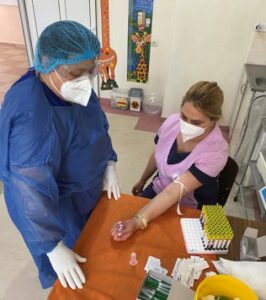
CHS Publishes on Prevalence of Hepatitis B Virus Infection Among General Population of Armenia
2 min readYEREVAN, Armenia — The Turpanjian College of Health Sciences (CHS) at the American University of Armenia (AUA) has recently published an article entitled “Prevalence of hepatitis B virus infection among general population of Armenia in 2021 and factors associated with it: a cross-sectional study.” It appears in BMJ Open, a prestigious highly-cited peer-reviewed journal with a wide scope of interest in public health and medicine. The lead author of the paper is Dr. Anahit Demirchyan (MPH ’99). The authors hail from various institutions and organizations, thanks to the collaborative efforts through which the study became a reality. Dr. Demirchyan, Serine Sahakyan (MPH ’15), Lusine Aslanyan (MPH ’18), Diana Muradyan (MPH ’20), Lusine Musheghyan (MPH ’13), and CHS Dean Dr. Varduhi Petrosyan represented the AUA, while Sandra Dudareva represented the Robert Koch Institute, Antons Mozalevskis and Gayane Ghukasian the World Health Organization (WHO), and Narina Sargsyants the National Institute of Health and the Ministry of Health (MOH) of Armenia.
The paper is based on the findings of the first nationwide representative seroprevalence study of hepatitis B virus markers in Armenia, conducted by CHS in 2021 with technical and partial financial support from the WHO Regional Office for Europe. It provides robust estimates of the prevalence of hepatitis B infection ever in life (14.1%) and chronic hepatitis B infection (0.8%) among the general population of Armenia and highlights the factors associated with this condition. For chronic hepatitis B infection, these factors include less than secondary education, active smoking, and chronic liver disease. Hepatitis B infection ever in life is related to all these factors as well as to older age, imprisonment ever in life, poor knowledge of infectious diseases, and residing in the regions, as opposed to Yerevan. The findings of this study strengthen the knowledge base necessary for developing effective interventions for reducing hepatitis B infection in Armenia. Many of the findings of this study could reflect a general pattern typical in other comparable countries. Therefore, the lessons derived from this paper could be applicable in other countries with a socio-economic background similar to that in Armenia.
The AUA Turpanjian College of Health Sciences works actively to improve population health and health services in Armenia and the region through interdisciplinary education and development of health professionals to be leaders in public health, nursing, health services research and evaluation, and health care delivery and management.

